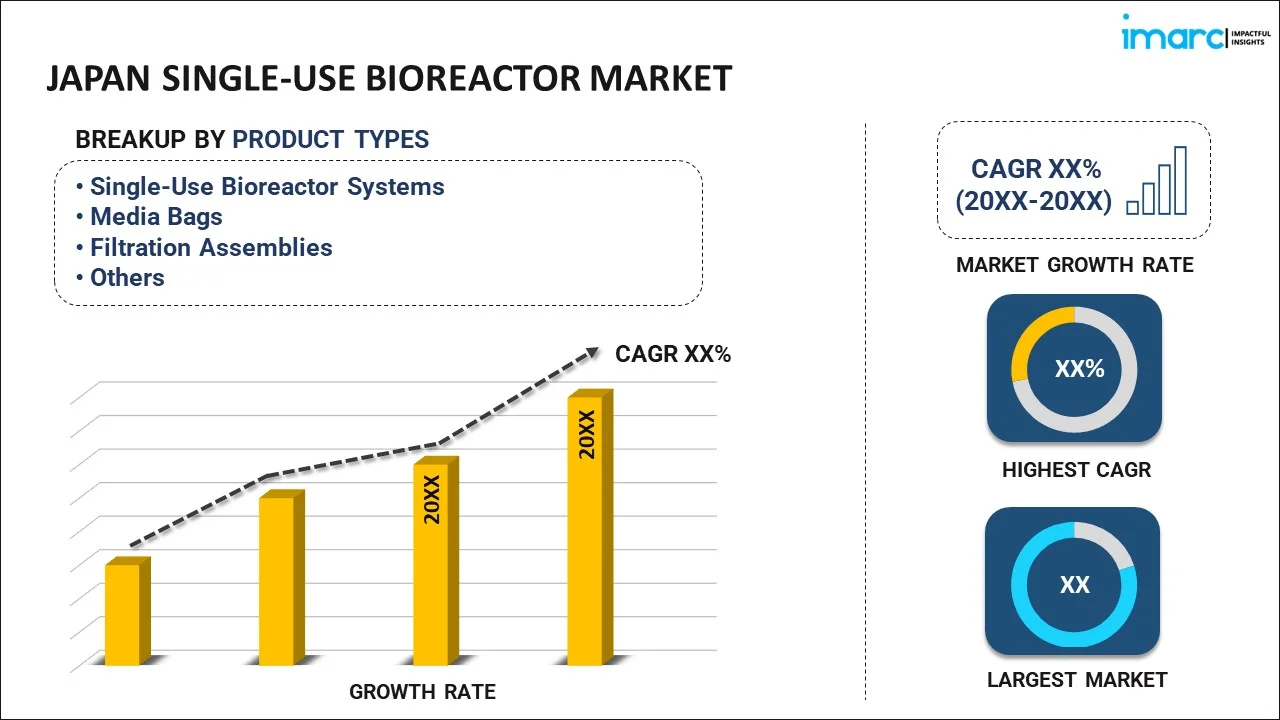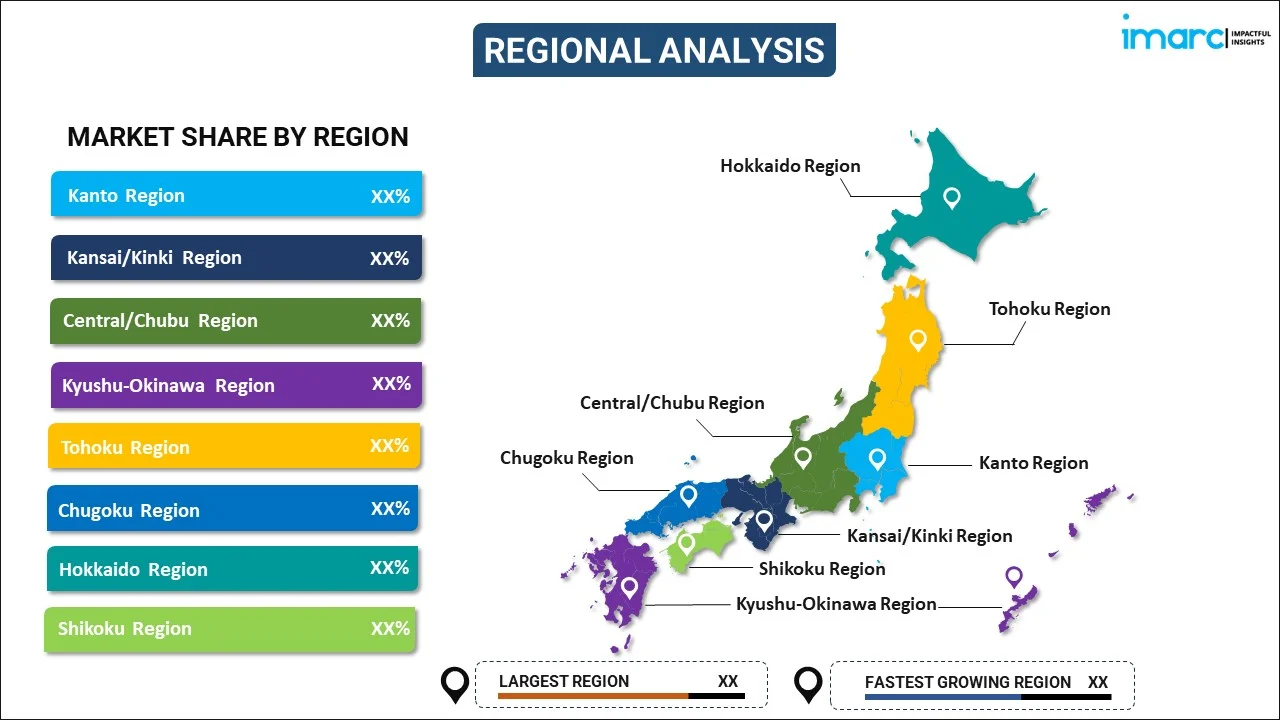
Japan Single-use Bioreactor Market Report by Product Type (Single-Use Bioreactor Systems, Media Bags, Filtration Assemblies, and Others), Type (Stirred-Tank Bioreactors, Wave-Induced Bioreactors, Bubble-Column Bioreactors, and Others), Cell Type (Mammalian Cell, Bacteria, Yeast, and Others), Molecule Type (Vaccines, Monoclonal Antibodies, Stem Cells, Recombinant Proteins, and Others), End User (Pharmaceutical and Biopharmaceutical Companies, Contract Research Organizations, Academic and Research Institutes, and Others), and Region 2025-2033
Market Overview:
Japan single-use bioreactor market size reached USD 225.2 Million in 2024. Looking forward, IMARC Group expects the market to reach USD 845.8 Million by 2033, exhibiting a growth rate (CAGR) of 15.8% during 2025-2033. The increasing demand for biologic drugs, such as monoclonal antibodies, vaccines, and cell therapies, which has enhanced the need for efficient and cost-effective bioreactor solutions, is driving the market.
|
Report Attribute
|
Key Statistics
|
|---|---|
|
Base Year
|
2024 |
|
Forecast Years
|
2025-2033 |
|
Historical Years
|
2019-2024
|
| Market Size in 2024 | USD 225.2 Million |
| Market Forecast in 2033 | USD 845.8 Million |
| Market Growth Rate (2025-2033) | 15.8% |
A single-use bioreactor is a specialized piece of equipment used in biotechnology and pharmaceutical industries for the cultivation of cells, microorganisms, or tissues for the production of biological products like vaccines, monoclonal antibodies, and recombinant proteins. Unlike traditional stainless steel bioreactors, single-use bioreactors are designed for one-time use and do not require extensive cleaning and sterilization between batches. These bioreactors consist of a disposable, sterile plastic bag or container that serves as the culture vessel. They are equipped with sensors, controllers, and connectors for monitoring and controlling critical process parameters such as temperature, pH, dissolved oxygen, and agitation speed. Single-use bioreactors offer several advantages, including reduced risk of contamination, faster setup, and flexibility in scaling up or down production processes. Their flexibility and cost-effectiveness make single-use bioreactors particularly useful for small-scale research, clinical trials, and the production of niche or orphan drugs. They have revolutionized bioprocessing by simplifying operations and accelerating the development and manufacturing of biopharmaceuticals.
Japan Single-use Bioreactor Market Trends:
The single-use bioreactor market in Japan is experiencing robust growth due to several key drivers. Firstly, the increasing demand for biopharmaceuticals is propelling the market forward. As the pharmaceutical industry continues to shift towards biologics and personalized medicine, the need for efficient and flexible bioreactor solutions has surged. Additionally, the cost-effectiveness of single-use bioreactors is a significant driver. These systems eliminate the need for costly cleaning and validation processes associated with traditional stainless steel bioreactors, making them an attractive choice for both established and emerging biotech companies. Furthermore, the rapid advancements in biotechnology and bioprocessing technologies are driving innovation in single-use bioreactors. Manufacturers are continuously improving these systems, enhancing their scalability and enabling better process control and automation. Moreover, regulatory support and guidelines for single-use bioreactors have become more comprehensive, providing a favorable environment for market growth. In conclusion, the single-use bioreactor market in Japan is thriving due to increasing demand, cost-effectiveness, technological advancements, and regulatory support.
Japan Single-use Bioreactor Market Segmentation:
IMARC Group provides an analysis of the key trends in each segment of the market, along with forecasts at the country level for 2025-2033. Our report has categorized the market based on product type, type, cell type, molecule type, and end user.
Product Type Insights:

- Single-Use Bioreactor Systems
- Media Bags
- Filtration Assemblies
- Others
The report has provided a detailed breakup and analysis of the market based on the product type. This includes single-use bioreactor systems, media bags, filtration assemblies, and others.
Type Insights:
- Stirred-Tank Bioreactors
- Wave-Induced Bioreactors
- Bubble-Column Bioreactors
- Others
A detailed breakup and analysis of the market based on the type have also been provided in the report. This includes stirred-tank bioreactors, wave-induced bioreactors, bubble-column bioreactors, and others.
Cell Type Insights:
- Mammalian Cell
- Bacteria
- Yeast
- Others
The report has provided a detailed breakup and analysis of the market based on the cell type. This includes mammalian cell, bacteria, yeast, and others.
Molecule Type Insights:
- Vaccines
- Monoclonal Antibodies
- Stem Cells
- Recombinant Proteins
- Others
A detailed breakup and analysis of the market based on the molecule type have also been provided in the report. This includes vaccines, monoclonal antibodies, stem cells, recombinant proteins, and others.
End User Insights:
- Pharmaceutical and Biopharmaceutical Companies
- Contract Research Organizations
- Academic and Research Institutes
- Others
The report has provided a detailed breakup and analysis of the market based on end user. This includes pharmaceutical and biopharmaceutical companies, contract research organizations, academic and research institutes, and others.
Regional Insights:

- Kanto Region
- Kansai/Kinki Region
- Central/ Chubu Region
- Kyushu-Okinawa Region
- Tohoku Region
- Chugoku Region
- Hokkaido Region
- Shikoku Region
The report has also provided a comprehensive analysis of all the major regional markets, which include Kanto Region, Kansai/Kinki Region, Central/ Chubu Region, Kyushu-Okinawa Region, Tohoku Region, Chugoku Region, Hokkaido Region, and Shikoku Region.
Competitive Landscape:
The market research report has also provided a comprehensive analysis of the competitive landscape. Competitive analysis such as market structure, key player positioning, top winning strategies, competitive dashboard, and company evaluation quadrant has been covered in the report. Also, detailed profiles of all major companies have been provided.
Japan Single-use Bioreactor Market Report Coverage:
| Report Features | Details |
|---|---|
| Base Year of the Analysis | 2024 |
| Historical Period | 2019-2024 |
| Forecast Period | 2025-2033 |
| Units | Million USD |
| Scope of the Report |
Exploration of Historical Trends and Market Outlook, Industry Catalysts and Challenges, Segment-Wise Historical and Future Market Assessment:
|
| Product Types Covered | Single-Use Bioreactor Systems, Media Bags, Filtration Assemblies, Others |
| Types Covered | Stirred-Tank Bioreactors, Wave-Induced Bioreactors, Bubble-Column Bioreactors, Others |
| Cell Types Covered | Mammalian Cell, Bacteria, Yeast, Others |
| Molecule Types Covered | Vaccines, Monoclonal Antibodies, Stem Cells, Recombinant Proteins, Others |
| End Users Covered | Pharmaceutical and Biopharmaceutical Companies, Contract Research Organizations, Academic and Research Institutes, Others |
| Regions Covered | Kanto Region, Kansai/Kinki Region, Central/ Chubu Region, Kyushu-Okinawa Region, Tohoku Region, Chugoku Region, Hokkaido Region, Shikoku Region |
| Customization Scope | 10% Free Customization |
| Post-Sale Analyst Support | 10-12 Weeks |
| Delivery Format | PDF and Excel through Email (We can also provide the editable version of the report in PPT/Word format on special request) |
Key Questions Answered in This Report:
- How has the Japan single-use bioreactor market performed so far and how will it perform in the coming years?
- What has been the impact of COVID-19 on the Japan single-use bioreactor market?
- What is the breakup of the Japan single-use bioreactor market on the basis of product type?
- What is the breakup of the Japan single-use bioreactor market on the basis of type?
- What is the breakup of the Japan single-use bioreactor market on the basis of cell type?
- What is the breakup of the Japan single-use bioreactor market on the basis of molecule type?
- What is the breakup of the Japan single-use bioreactor market on the basis of end user?
- What are the various stages in the value chain of the Japan single-use bioreactor market?
- What are the key driving factors and challenges in the Japan single-use bioreactor?
- What is the structure of the Japan single-use bioreactor market and who are the key players?
- What is the degree of competition in the Japan single-use bioreactor market?
Key Benefits for Stakeholders:
- IMARC’s industry report offers a comprehensive quantitative analysis of various market segments, historical and current market trends, market forecasts, and dynamics of the Japan single-use bioreactor market from 2019-2033.
- The research report provides the latest information on the market drivers, challenges, and opportunities in the Japan single-use bioreactor market.
- Porter's five forces analysis assist stakeholders in assessing the impact of new entrants, competitive rivalry, supplier power, buyer power, and the threat of substitution. It helps stakeholders to analyze the level of competition within the Japan single-use bioreactor industry and its attractiveness.
- Competitive landscape allows stakeholders to understand their competitive environment and provides an insight into the current positions of key players in the market.
Need more help?
- Speak to our experienced analysts for insights on the current market scenarios.
- Include additional segments and countries to customize the report as per your requirement.
- Gain an unparalleled competitive advantage in your domain by understanding how to utilize the report and positively impacting your operations and revenue.
- For further assistance, please connect with our analysts.
 Inquire Before Buying
Inquire Before Buying
 Speak to an Analyst
Speak to an Analyst
 Request Brochure
Request Brochure
 Request Customization
Request Customization




.webp)




.webp)












